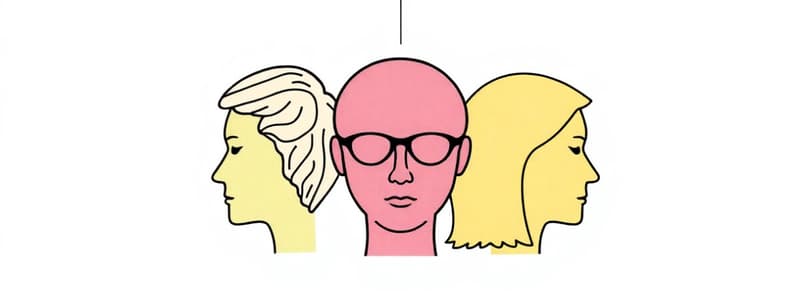Podcast
Questions and Answers
Which of the following Big Five personality dimensions is most closely associated with an individual's ability to withstand stress?
Which of the following Big Five personality dimensions is most closely associated with an individual's ability to withstand stress?
- Conscientiousness
- Agreeableness
- Extraversion
- Emotional stability (correct)
According to situation strength theory, when will personality traits be MOST likely to predict behavior?
According to situation strength theory, when will personality traits be MOST likely to predict behavior?
- In situations where consequences for decisions are severe
- In weak situations with ambiguous cues and standards (correct)
- In situations with many external forces limiting individual action
- In strong situations with clear norms and expectations
What is the primary focus of trait activation theory (TAT)?
What is the primary focus of trait activation theory (TAT)?
- Analyzing how personality traits influence job performance
- Identifying situations that 'activate' specific personality traits (correct)
- Determining the overall impact of personality on organizational behavior
- Predicting behavior based on the strength of the situation
Which of the following is LEAST likely to be associated with high Machiavellianism?
Which of the following is LEAST likely to be associated with high Machiavellianism?
What best describes the concept of 'person-organization fit'?
What best describes the concept of 'person-organization fit'?
In Hofstede's framework for assessing cultures, what does 'power distance' refer to?
In Hofstede's framework for assessing cultures, what does 'power distance' refer to?
Which of the following is a characteristic of a collectivist culture, according to Hofstede's framework?
Which of the following is a characteristic of a collectivist culture, according to Hofstede's framework?
What is the role of personality in organizational behavior?
What is the role of personality in organizational behavior?
Maslow's Hierarchy of Needs is a well-known theory of motivation. Which of the following needs does it include?
Maslow's Hierarchy of Needs is a well-known theory of motivation. Which of the following needs does it include?
McClelland's Theory of Needs focuses on three needs. What are they?
McClelland's Theory of Needs focuses on three needs. What are they?
Self-determination theory posits that people prefer to feel they have control over their actions. What is a potential implication of this theory for providing rewards?
Self-determination theory posits that people prefer to feel they have control over their actions. What is a potential implication of this theory for providing rewards?
According to goal-setting theory, what type of goals lead to the highest performance, assuming acceptance and ability are constant?
According to goal-setting theory, what type of goals lead to the highest performance, assuming acceptance and ability are constant?
Which of the following best describes 'enactive mastery,' as it relates to self-efficacy theory?
Which of the following best describes 'enactive mastery,' as it relates to self-efficacy theory?
In equity theory, what do individuals compare to determine if they are being treated fairly?
In equity theory, what do individuals compare to determine if they are being treated fairly?
What is the primary focus of procedural justice?
What is the primary focus of procedural justice?
According to expectancy theory, what is the 'effort-performance relationship'?
According to expectancy theory, what is the 'effort-performance relationship'?
Which core job dimension in the Job Characteristics Model (JCM) refers to the degree to which a job requires a variety of different activities?
Which core job dimension in the Job Characteristics Model (JCM) refers to the degree to which a job requires a variety of different activities?
What is the primary benefit of job rotation?
What is the primary benefit of job rotation?
What does leadership involve?
What does leadership involve?
What is a primary component of transformational leadership?
What is a primary component of transformational leadership?
Flashcards
Extraversion
Extraversion
Comfort level with relationships; Extroverts are gregarious, assertive, sociable; Introverts are reserved, timid, quiet.
Agreeableness
Agreeableness
Individual's propensity to defer to others; High = cooperative, warm, trusting; Low = cold, disagreeable, antagonistic.
Conscientiousness
Conscientiousness
Measure of reliability; High = responsible, organized, dependable, persistent; Low = distracted, disorganized, unreliable.
Emotional Stability
Emotional Stability
Signup and view all the flashcards
Openness to Experience
Openness to Experience
Signup and view all the flashcards
Situation Strength Theory
Situation Strength Theory
Signup and view all the flashcards
Situation Strength
Situation Strength
Signup and view all the flashcards
Trait Activation Theory (TAT)
Trait Activation Theory (TAT)
Signup and view all the flashcards
Proactive Personality
Proactive Personality
Signup and view all the flashcards
Machiavellianism
Machiavellianism
Signup and view all the flashcards
Narcissism
Narcissism
Signup and view all the flashcards
Person-Organization Fit
Person-Organization Fit
Signup and view all the flashcards
Power Distance
Power Distance
Signup and view all the flashcards
Individualism vs. Collectivism
Individualism vs. Collectivism
Signup and view all the flashcards
Masculinity vs. Femininity
Masculinity vs. Femininity
Signup and view all the flashcards
Uncertainty Avoidance
Uncertainty Avoidance
Signup and view all the flashcards
Long-Term vs. Short-Term Orientation
Long-Term vs. Short-Term Orientation
Signup and view all the flashcards
Goal-Setting Theory
Goal-Setting Theory
Signup and view all the flashcards
Self-Efficacy Theory
Self-Efficacy Theory
Signup and view all the flashcards
Equity Theory
Equity Theory
Signup and view all the flashcards
Study Notes
Individual Differences and the Big Five Personality Model
- Individual differences, like personality traits, are valuable in forecasting organizational attitudes and behaviors
- Research indicates that five basic dimensions underlie all personality dimensions
The Five Basic Dimensions of Personality
- Extraversion reflects comfort with relationships; extroverts are gregarious, assertive, and sociable, while introverts are reserved, timid, and quiet
- Agreeableness is the tendency to defer to others; high agreeableness involves being cooperative, warm, and trusting, while low agreeableness involves being cold, disagreeable, and antagonistic
- Conscientiousness measures reliability; high conscientiousness means being responsible, organized, dependable, and persistent, while low conscientiousness means being easily distracted, disorganized, and unreliable
- Emotional stability refers to the ability to withstand stress; positive emotional stability means being calm, self-confident, and secure, while negative emotional stability means being nervous, anxious, depressed, and insecure
- Openness to experience is the range of interests and fascination with novelty; highly open people are creative, curious, and artistically sensitive, while those at the opposite end are conventional and prefer familiarity
Big Five Traits and Workplace Behavior
- Research demonstrates connections between personality dimensions and job performance
- Conscientiousness helps employees develop higher levels of job knowledge
- Conscientiousness is vital for managers and front-line employees; persistence, attention to detail, and high standards contribute to organizational success
- Conscientiousness is the best predictor of job performance, but other traits also influence performance in specific situations
Implications of the Big Five Traits
- Emotional stability is strongly linked to life satisfaction, job satisfaction, and low-stress levels
- Extraverts thrive in jobs requiring significant interpersonal interaction
- Open individuals are more likely to be effective leaders and are comfortable with ambiguity
- Agreeable people are generally better liked and excel in interpersonally-oriented jobs like customer service
Cross-Cultural Validity of the Big Five Model
- The five personality factors are consistent across various cultures, including China, Israel, Germany, Japan, Spain, Nigeria, Norway, Pakistan, and the United States
- Studies generally confirm that conscientiousness is the best predictor of job performance
Personality and Situations
- The effect of traits on behavior depends on the situation
- Situation strength theory suggests that personality translates into behavior based on the strength of the situation
- Situation strength is the degree to which norms, cues, or standards dictate suitable behavior
- Personality traits are better predictors of behavior in weak situations versus strong ones
- Situation strength in organizations can be analyzed through four elements: Clarity, Consistency, Constraints, and Consequences
Understanding Situation Strength
- Clarity refers to the availability and clarity of cues about work duties and responsibilities
- Consistency is the extent to which cues regarding work duties are compatible
- Constraints are the limits on an individual's freedom to act due to external forces
- Consequences are the implications of decisions or actions for the organization
Organizational Situations
- Organizations are sometimes considered strong situations due to imposed rules and norms
- Trait Activation Theory (TAT) predicts that certain situations, events, or interventions activate specific traits
- Specific traits like narcissism, proactivity, and Machiavellianism are relevant in particular situations
- Proactive personalities take initiative to improve circumstances, show initiative, take action, and persevere
- Individuals high in Machiavellianism are pragmatic, emotionally distant, and believe ends justify means; they are manipulative and persuasive
Core Self-Evaluations
- Core self-evaluations reflect how people perceive themselves
- Understanding differences between trait activation theory and situation strength theory is crucial
Linking Personality and Values to the Workplace
- Person-Job Fit, articulated in John Holland’s theory, emphasizes aligning personality with job characteristics
- Person-Organization Fit suggests people seek organizations that match their values and leave those that don't align with their personalities Other dimensions of fit include Person-Group fit and Person-Supervisor fit, which impact workplace outcomes
Cultural Values
- Hofstede's Framework assesses cultures based on five value dimensions
- Power distance is the degree to which people accept unequal power distribution
- Individualism versus collectivism reflects preferences for individual or group actions; individualism favors individual actions, while collectivism emphasizes a tight social framework
- Masculinity versus femininity indicates whether a culture favors traditional masculine roles or views men and women as equals
- Uncertainty avoidance is the degree to which people prefer structured situations
- Long-term versus short-term orientation focuses on valuing the future versus the present
- Asian countries are generally more collectivistic than individualistic
- The United States ranks high on individualism
- Germany and Hong Kong rate high on masculinity
- Russia and The Netherlands rate low on masculinity
- China and Hong Kong exhibit a long-term orientation
- France and the United States exhibit a short-term orientation
Implications for Managers
- Personality influences organizational behavior; it sets the stage but does not explain all behavior
- The Big Five traits are essential, but the Dark Triad also matters
- Individuals should be placed in situations aligning with their personality to optimize performance
- Consider screening for high conscientiousness and other relevant Big Five traits
- Job and work group evaluations should determine the optimal personality fit
- Situational factors should be considered when evaluating personality traits, and cultural differences must be respected to promote a positive organizational climate
Defining Motivation
- Motivation varies both between individuals and within individuals at different times.
- Motivation encompasses the processes accounting for an individual's intensity, direction, and persistence of effort toward attaining a goal
- Organizational goals should be the target in the workplace
- Intensity, Direction and Persistence are the key elements
Early Theories of Motivation
- The 1950s saw the formulation of three specific theories
- Early theories provide a foundation for contemporary theories
Hierarchy of Needs Theory
- Abraham Maslow's hierarchy of needs orders five needs
- Physiological needs relate to hunger, thirst, shelter, and bodily needs
- Safety needs relate to security and protection from harm
- Social needs relate to affection, belongingness, acceptance, and friendship
- Esteem needs include internal factors like self-respect and external factors like recognition
- Self-actualization involves achieving one's potential and self-fulfillment
- A satisfied need no longer motivates, and Maslow separated the five needs into higher and lower orders
McClelland's Theory of Needs
- McClelland's theory focuses on achievement, power, and affiliation
- The need for achievement (nAch) involves excelling and achieving standards; successful performance requires a 50/50 probability of success and acceptance of reasonable risk
Contemporary Theories of Motivation
- Contemporary theories share reasonable supporting documentation
- Self-determination theory proposes people prefer control over their actions; obligations undermine this motivation
- Cognitive evaluation theory suggests that extrinsic rewards reduce intrinsic interest
- People seek competence, positive connections, and autonomy
- Rewards for accepting imposed standards can feel coercive
- Self-concordance considers how strongly reasons for pursuing goals align with interests and values
- Choose jobs for intrinsic rather than extrinsic reasons to promote job satisfaction
- Managers should provide both intrinsic and extrinsic incentives
Goal-Setting Theory
- Edwin Locke proposed that intentions to work toward a goal greatly impact work motivation
- Goals clarify expectations and effort requirements
- Specific and difficult goals, if accepted, improve performance; feedback then further increases performance
- Specific, hard goals outperform generalized goals
- The Contingencies in goal-setting theory include goal commitment, task characteristics, and national culture
- Goal commitment is when someone believes that they can achieve a goal; goals affect performance most when tasks are simple and independent
- On interdependent tasks, group goals are preferable
- In collectivistic and high-power distance cultures, moderate goals are more motivating
- Goals related to performance may hurt adaptation and creativity
- Goals may cause an employee to strongly focus on a single standard, excluding all other
- Goals are powerful in shaping behavior
Promotion and Prevention Focus
- Some people have a promotion focus and strive for accomplishments
- Others have a prevention focus and strive to fulfill obligations
Self-Efficacy Theory
- It refers to a belief that a person is capable of performing a task
- The more self-efficacy, the easier to have the confidence for success
- Higher self-efficacy will help a person to be more engaged in their tasks
- Enactive mastery is gaining relevant experience
- Vicarious modeling includes gaining confidence due to someone else being seen doing the task
- Verbal persuasion involves being more confident since someone persuaded convinces a person that they have the skills to do said task
- Arousal helps to lead to an energized state driving a person to complete the task
- verbal persuasion can occur through the Pygmalion or Galatea Effect
Equity Theory/Organizational Justice
- A person needs to contribute job-related inputs and outcomes relative to other individuals to eliminate any inequalities
- Equity exists when a person has a ratio to relevant others with whom the person compares them to
- People will attempt to alter their inputs/outputs if inequity rises or leave
- Organizational justice is how workers are treated with justice along four dimensions
Distributive Justice
- Includes fairness of outcomes, like pay
- Although a fair outcome is important, the method of dispensing it is also important
Procedural Justice
- Addresses how outcomes are allocated
- Direct influence over how decisions are made creates control
- Employees perceive that procedures are fair if decision makers follow said rules
Combination of Justice
- Procedural and distributive justice can influence perceptions of fairness Informational and interpersonal justice are important during interactions with other parties
Expectancy Theory
- Claims a person will act depending on the expectation that they can complete an action and their beliefs in achieving desirable outcomes
- A person is motivated to perform at a high level if they believe such
- A good effort will lead to a good appraisal
- Good appraisal will lead to organizational rewards
- Rewards will lead to them achieving personal goals
Key Relationships
- The effort-performance relationship means the probability that a person puts in effort and it leads to success
- Performance-reward relationship is the belief that performing at a good level will lead to reward
- Rewards-personal goal relationships are when rewards achieved and work-related items will lead to an interest in a person's personal goals
Using other theories
- Goal setting theory is important since goals will result in high productivity
- Reinforcement theory is important to maintain work quantity, rates and consistency
Motivating by Job Design
- The job characteristics model determines that a job can be analyzed along with the dimensions of the following:
- Skill variety with using a number of talents and capabilities in the workplace
- Task identity, making them complete a task fully
- The measure of what a job helps the lives of other people
- Autonomy is when that job provides a sense of worker freedom and the ability to schedule work and determine their own procedures
- Feedback generates direct information about any person's performance
Job Redesign
- Repetitive jobs can result in people seeking opportunities, and autonomy or motivation will need to arise
- Job rotation refers to shifting an individual from tasks periodically which can also be referred to as cross-training
- Boredom can be reduced, and employees can get a better understanding of the work contributions
Important factors
- There can be draws such as disruptions and extra training time
- Maslow and McClelland's theories do not have widespread support
Effective Leadership
- Leadership is the process of influencing others to mobilize individual and collective efforts
- This is toward the accomplishment of goals or objectives
- A wider view considers the interaction between the leader behaviors, traits, roles
- The factors of the follower's (readiness, motivation, behaviors, traits, roles), and the context (time, task, outcome criteria)
Trait Theories
- Trait theories of leadership focus on personal qualities and characteristics
- Leaders who can assert themselves (extraverted), who are disciplined and are creative
- Leaders do have key traits in common
Behavioral Theories
- Behavioral theories imply we can train people to be leaders
- The Ohio State Studies narrow the list of leadership to two categories: initiating structure and consideration
- Initiating structure is the search for goal attainment
- Consideration is in relationships that are characterized by respect, trust and regard
Contingency Theories
- Page | 2 Tough-minded leaders are important when there is tough times
- The Fiedler Model determines with contingency on group performance from the proper match with the degree in the situation to control the other leaders
Identifying leadership style
- Key is a key factor in basic leadership
- To measure leadership as a base he uses the LPC questionnaire
- To measure the task use the relationship-oriented checklist
- Leader-member relations are an advantage when there is confidence, respect, and trust to their leader
Situation Characteristics
- Task structure refers to the nature of jobs
- Position power will help by hiring, firing, determining salary, etc
- Fiedler's is one of the best models
Situational Leadership Theory
- Says successful leadership can be achieved with the followers level of readiness
- Robert House made leadership on expectancy and research on initial structure and consideration
- Leader-Participation model
- Leader-participation model helps make a better decision Task structure must reflect structure
Relational Theories
- Leaders establish relationships with followers
- There are individuals making good impressions that are trustworthy
- Leader will categorize the follower with in or out style and relationship will need to be stable
Charismatic Leadership
- Leaders act as a form of hero worship
- This can occur through actions like making a new vision
- There needs to a effective charismatic leadership
- This can be used when there is high-stress or uncertainty
Transformational Leaders
- They increase follower self-efficacy
- This creates a can-do attitude
- Vision helps explain how charismatic and transformational
- Need to instill commitment from others
Trust
- Leads a person to become riskier
- Encourages taking risks
- Will trust in facilitators
- Leads to enhance and provide positive performance of others
Challenges to Leadership
- Often relies on external factors
- Attribution makes it based on other leaders which is based on something
- In some cases, there is irrelevant actions
- The behavioral had major results
- Contemporary theories has studies on leadership
- It requires transformational capabilities and can work through other
- Need to build good positive relationships
Studying That Suits You
Use AI to generate personalized quizzes and flashcards to suit your learning preferences.




